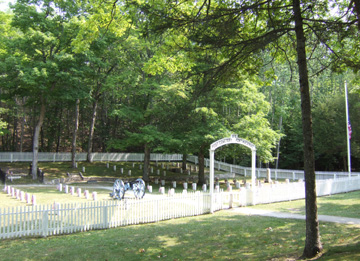|
Fort Mackinac Post Cemetery
Mackinac State Park
Mackinac Island, MI 49757
|
Office Hours:
See General Information
Visitation Hours:
Open daily from sunrise to sunset.
|
|

|
Burial Space: This cemetery is closed to interments.
Acreage: 0.3
Floral/Ground Regulations
|
|
Directions from nearest airport:
Travel north on Interstate 69 to US 27. Take US 27 North to Interstate 75. Take Interstate 75 North to Mackinac City. In Mackinac City take the ferry landing exit. Take the ferry (fee charged) to Mackinac Island. Cemetery is located behind the fort.
|
GENERAL INFORMATION
There is no office at this cemetery. It is overseen by Great Lakes National Cemetery.
Please contact the national cemetery for more information.
back to top
HISTORICAL INFORMATION
Located in the Straights of Mackinac, which connect Lake Michigan and Lake Huron, Mackinac Island played a significant role in early American history due to its strategic location. Control of the island changed hands numerous times leading up to and after the establishment of the American republic. The French first occupied Mackinac Island in the 17th century, surrendering it to the British after the French and Indian War. The British fortified the island toward the end of the Revolutionary War, yielding it to the United States in 1796. British forces recaptured the fort at the outbreak of the War of 1812, only to relinquish control to the Americans again at the cessation of the war.
Fort Mackinac Post Cemetery is located approximately a half mile north of Fort Mackinac, near Skull Cave, a burial site for American Indians. The earliest interments in the post cemetery likely date to the mid-1820’s. The military occupation of Fort Mackinac throughout the 18th century suggests there was an earlier post cemetery, yet the location of pre-1820’s burials remains elusive. The earliest interments are located on the north and west sides of the post cemetery, which was enlarged between 1873 and 1890.
In 1875, in response to the increasing popularity of Mackinac Island as a tourist destination, the federal government established Mackinac Island National Park. It was the second national park established in the United States, after Yellowstone National Park. With the close of Fort Mackinac in 1895, military operations on the island came to a halt, and the federal government ceded the park to the state of Michigan.
Throughout most of the 20th century, the state maintained the grounds, save for a period in the late 1930’s, when the Civilian Conservation Corps, a New Deal work-relief program, landscaped and improved the cemetery. In 1990, the Department of Veterans Affairs assumed responsibility for the maintenance of the cemetery through an agreement with the state.
Today, the rectangular post cemetery is bounded by a white picket fence with a wooden archway marking the entrance. Of the approximately 108 burials in Fort Mackinac Post Cemetery, 69 are unknown. In addition to the soldiers and their families, six civilians are interred at the post cemetery.
Mackinac Island, Michigan, including Fort Mackinac Post Cemetery, was designated as a National Historic Landmark in 1960.
back to top
NOTABLE PERSONS
back to top
FLORAL/GROUNDS REGULATIONS
Floral arrangements are not authorized at any time in the cemetery.
back to top
|


